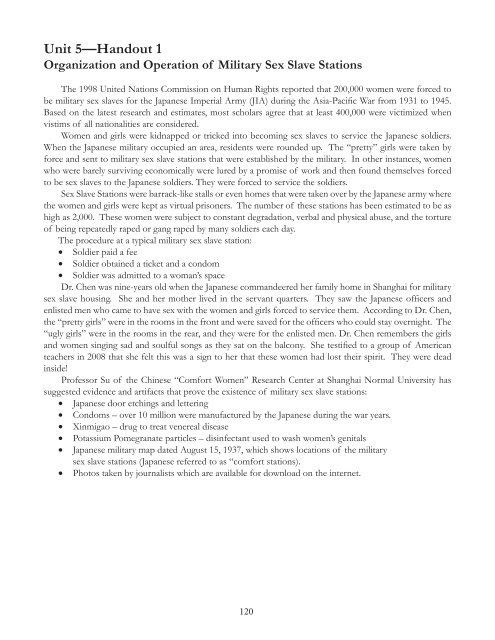Download - Canada ALPHA
Download - Canada ALPHA
Download - Canada ALPHA
Create successful ePaper yourself
Turn your PDF publications into a flip-book with our unique Google optimized e-Paper software.
Unit 5—Handout 1<br />
Organization and Operation of Military Sex Slave Stations<br />
The 1998 United Nations Commission on Human Rights reported that 200,000 women were forced to<br />
be military sex slaves for the Japanese Imperial Army (JIA) during the Asia-Pacifi c War from 1931 to 1945.<br />
Based on the latest research and estimates, most scholars agree that at least 400,000 were victimized when<br />
vistims of all nationalities are considered.<br />
Women and girls were kidnapped or tricked into becoming sex slaves to service the Japanese soldiers.<br />
When the Japanese military occupied an area, residents were rounded up. The “pretty” girls were taken by<br />
force and sent to military sex slave stations that were established by the military. In other instances, women<br />
who were barely surviving economically were lured by a promise of work and then found themselves forced<br />
to be sex slaves to the Japanese soldiers. They were forced to service the soldiers.<br />
Sex Slave Stations were barrack-like stalls or even homes that were taken over by the Japanese army where<br />
the women and girls were kept as virtual prisoners. The number of these stations has been estimated to be as<br />
high as 2,000. These women were subject to constant degradation, verbal and physical abuse, and the torture<br />
of being repeatedly raped or gang raped by many soldiers each day.<br />
The procedure at a typical military sex slave station:<br />
• Soldier paid a fee<br />
• Soldier obtained a ticket and a condom<br />
• Soldier was admitted to a woman’s space<br />
Dr. Chen was nine-years old when the Japanese commandeered her family home in Shanghai for military<br />
sex slave housing. She and her mother lived in the servant quarters. They saw the Japanese offi cers and<br />
enlisted men who came to have sex with the women and girls forced to service them. According to Dr. Chen,<br />
the “pretty girls” were in the rooms in the front and were saved for the offi cers who could stay overnight. The<br />
“ugly girls” were in the rooms in the rear, and they were for the enlisted men. Dr. Chen remembers the girls<br />
and women singing sad and soulful songs as they sat on the balcony. She testifi ed to a group of American<br />
teachers in 2008 that she felt this was a sign to her that these women had lost their spirit. They were dead<br />
inside!<br />
Professor Su of the Chinese “Comfort Women” Research Center at Shanghai Normal University has<br />
suggested evidence and artifacts that prove the existence of military sex slave stations:<br />
• Japanese door etchings and lettering<br />
• Condoms – over 10 million were manufactured by the Japanese during the war years.<br />
• Xinmigao – drug to treat venereal disease<br />
• Potassium Pomegranate particles – disinfectant used to wash women’s genitals<br />
• Japanese military map dated August 15, 1937, which shows locations of the military<br />
sex slave stations (Japanese referred to as “comfort stations).<br />
• Photos taken by journalists which are available for download on the internet.<br />
120


